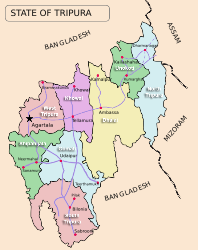Gomati (district)
| Gomati district | |
|---|---|

|
|
| State | Tripura |
| Administrative headquarters : | Udaipur |
| Area : | 1522.8 km² |
| Residents : | 429,237 (2011) |
| Population density : | 282 inhabitants / km² |
| Website : | official website |
The Gomati District is a district in the Indian state of Tripura . The administrative seat is the city of Udaipur .
geography
The Gomati district is located in the western half of Tripura on the border with Bangladesh . The area of the district is 1523 square kilometers. Neighboring districts are Khowai districts in the north, Dhalai districts in the northeast and east, South Tripura in the south and southwest, and Shipahijala in the west. In the east and southeast, the district borders on India's neighboring state, Bangladesh.
history
The district was created when the administrative areas of Tripura were redistributed on January 21, 2012 from the RD blocks Amarpur, Kakraban, Karbuk, Killa, Matabari and Ompi and the cities of Amarpur and Udaipur from the northern areas of the previous district of South Tripura .
population
According to the 2011 census, the Gomati district has 429,237 inhabitants. The district is densely populated with 282 inhabitants per square kilometer. Of the 429,237 residents, 345,265 people (80.44 percent) live in rural communities and 83,972 people in urban areas.
The district of Gomati is one of the areas of Tripura in which numerous members of the “tribal population” ( scheduled tribes ) settle. They included (2011) 177,356 people (41.32 percent of the district's population). In 2011, 74,397 people (17.33 percent of the district's population) belonged to the Dalit ( scheduled castes ).
Population development
As everywhere in India, the population in the Gomati district has been growing rapidly for decades. The 2001 Indian census found a population of 375,599 people. The increase in the years 2001–2011 was more than 14 percent (14.28%). In those ten years the population increased by more than 53,000 people.
Significant places
There are two urban settlements in the district with the district capital Udaipur and Amarpur. Statistically speaking, however, Dhwajnagar, Fulkumari, Gakulpur and Lebachhara are also considered cities (so-called census towns).

District population by gender
Of the 429,237 residents, 219,183 (51.06 percent) were male and 210,054 female. This is typical of India, where there is usually a significant increase in men.
District population by language
A small majority of the population speaks Bengali as their mother tongue. In the cities it is even over 90 percent. The Tripura language Kokborok is, however, the majority language in four of the six RD blocks. With between 53 and 73 percent of the respective population. The Mongsen and Chakma live almost entirely in the RD blocks Killa and Ompi or Armapur and Karbuk. The majority of speakers from Garo, Halam, Hindi and Mogh only live in one of the six RD blocks.
| year | Bengali | Kokborok | Mongsen | Chakma | Garo | Hindi | Halam | Other languages | Total | |||||||||
|---|---|---|---|---|---|---|---|---|---|---|---|---|---|---|---|---|---|---|
| number | % | number | % |% | number | % | number | % | number | % | number | % | number | % | number | % | number | % | |
| 2011 | 242,657 | 56.53 | 142,441 | 33.18 | 12,812 | 2.98 | 8884 | 2.07 | 4464 | 1.04 | 3590 | 0.84 | 2578 | 0.60 | 11,811 | 2.75 | 429.237 | 100.00% |
| Source: 2011 census result | ||||||||||||||||||
Population of the district by confession
The majority of the residents profess Hinduism. The majority of Bengali and Hindi speakers belong to their appendix. A minority among the Bengalis profess Islam. The majority of Buddhists are Chakma with a minority of Dalits. The majority of Christians belong to the “scheduled tribes” (tribal population) and the Dalit (also “untouchables”, casteless). Buddhists, Christians and Muslims form locally and regionally significant religious minorities. The following table shows the exact religious composition of the population:
| year | Buddhists | Christians | Hindus | Jainas | Muslims | Sikhs | Other | not specified | Total | |||||||||
|---|---|---|---|---|---|---|---|---|---|---|---|---|---|---|---|---|---|---|
| number | % | number | % | number | % | number | % | number | % | number | % | number | % | number | % | number | % | |
| 2011 | 12,294 | 2.86 | 28,283 | 6.59 | 349.192 | 81.35 | 42 | 0.01 | 38,139 | 8.89 | 112 | 0.03 | 570 | 0.13 | 605 | 0.14 | 429.237 | 100.00% |
| Source: 2011 census result | ||||||||||||||||||
education
The goal of full literacy is within reach. Of the 375,253 people aged seven and over, 321,281 (85.62 percent) can read and write. Literacy is well above the Indian average.
administration
With Amarpur, Karbuk and Udaipur, the new district has three sub-divisions (sub-districts), which are divided into the eight RD blocks Amarpur, Kakraban, Karbuk, Killa, Matabari, Ompi, Silachhari and Tepania.
Individual evidence
Web links
Coordinates: 23 ° 33 ′ 36 ″ N , 91 ° 30 ′ 0 ″ E